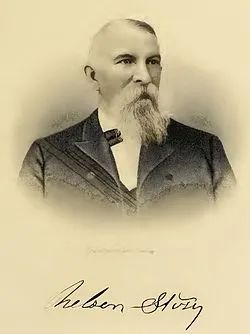
2008 MONTANA COWBOY HALL OF FAME INDUCTEE
1860 – 1920 LEGACY AWARD DISTRICT 9
Nelson Story (1838-1926)
Nelson Story was born in 1838 on a farm in Meigs County, Ohio. By the time he turned 21, both of his parents had died and, as he put it, he “lit out on his own.” In 1862, on the way to Missouri where he found a job hauling timber, he met Ellen Trent and married her in Kansas. Nelson found work in Missouri hauling timber. He and his bride moved farther west to the Colorado Territory. Familiar with animals, Nelson took a job as a teamster and hauled freight in the Breckenridge area. In 1863, by now a seasoned teamster, he headed for the Montana Territory with Ellen. Later in life he liked to tell how he started out with nothing but “a blind mule and a lame ox.”
Reaching Montana, the Storys resided in the mining towns of Bannack and Alder Gulch. Ellen baked bread and pies to sell to the miners, while Nelson operated a store and staked his own claims near the future site of Virginia City. After two years, he’d netted $30,000 in gold.
When the couple moved to Bozeman in 1864, Nelson pursued a new venture, trailing Texas cattle to Montana to supply beef to the miners and other settlers. He traveled to Fort Worth and bought a herd of Texas longhorns at $10 a head. Accounts vary widely, but the number of head ranged from 1,000 to 3,000. While on the trail, in Allen County, Kansas, U.S. Army Colonel Henry Carrington ordered Nelson to stop due to conflicts with the local Osage Indians. Nelson flouted the Colonel’s order and pushed north.
After four months on the trail, the herd arrived safely in the Bozeman area. More than 600 head were accounted for, having completed what is believed to be one of the longest cattle drives in history. The drive, well documented today, shows a harrowing journey crossing plains, rivers, mountains, and several different Indian nations. Skirmishes with Jayhawkers, rustlers, and Indians were common. Of the twenty-one Texas drovers who made the trip to Montana, one was killed and two were injured.
While not the first cattle herd driven to Montana, Nelson’s was the first driven from Texas to Montana, and marked the beginning of Montana’s cattle industry in Bozeman. From his ranch in the Paradise Valley along the Yellowstone River, he sold his beef at a profit ten times greater than the Texas price he’d paid.
In 1882, Nelson, anticipating the arrival of the Northern Pacific Railroad in Bozeman, constructed a water-powered flourmill. The Story Mill became the railroad’s first local customer and eventually the largest flourmill in operation in Montana. Nelson became the Montana Territory’s first millionaire. His mansion was the first built in Bozeman.
In 1876, the Army accused him of defrauding the Crow Indian Agency by selling them pork barrels filled with offal, charging for supplies never provided, and attempting to bribe an Army captain. Story never stood trial, reportedly later boasting about avoiding prosecution by bribing the grand jurors.
Nelson and Ellen laid the foundation for the Bozeman community, including the Montana State College. The Ellen Theater in downtown Bozeman was named for Mrs. Story.
Nelson Story died on March 10, 1926, at age 87 and is buried in Sunset Hills Cemetery in Bozeman. In 1959, he was inducted into the National Cowboy Hall of Fame in Oklahoma City.
Sources:
Entwistle, Bert. “A Man for His Time: Bozeman’s Nelson Story,” Working Ranch, September/October 2019.
Pickens, Jordon D. “The true story on Nelson Story.” (No additional information for this source was provided)

